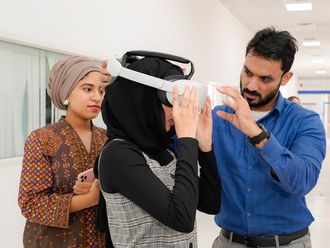Abu Dhabi: Dr Heikki Lyytinen, chair of the psychology department in the University of Jyvaskyla and the chairman of the Niilo Maki Foundation in Finland, is currently leading a task force on learning disability research.
The University of Jyvaskyla has implemented a programme in collaboration with the Abu Dhabi Education Council (Adec) to create a pedagogical fusion combining both the Abu Dhabi and Finnish experience, leading to the creation of world-class flagship schools in Abu Dhabi and Al Ain from 2010 until 2015.
He spoke to Gulf News on the varying facts of the learning disability to help parents struggling with children who need help.
Why does dyslexia occur in a child? What are the genetic triggers?
We followed children born to a family whose parent had serious problems in learning to read (had dyslexia). The likelihood that a child born to such a family will have dyslexia is about 0.5. In other words, every second child faces it and also the other half of the children in that family may have slight problems as well. Today, a number of candidate genes has been identified. We participated in identification of the first such gene. The full story is, however, still unknown. The most likely explanation is that there is a combination of mutations in more than one gene and it affects the neuronal migration at an early age. This is reflected in our results from 3-5 days old infants, whose brain showed signs which correlated to them later facing difficulties in learning to read.
Why does dyslexia go unnoticed? What are the reasons?
If teachers do not know about the dyslexia phenomenon, they typically interpret poor learning as a lack of intelligence or effort. We have children with very high IQs who have great difficulties in learning less than 30 connections between letters and the sounds they represent. Learning to read means only learning about the connections between letters and sounds. The meaning of the word need not to be known in the full.
Why is the UAE still not up to the mark in diagnosing dyslexia?
Research-based knowledge will provide methodologies for dyslexia diagnosis; however, the model currently used for Arabic dyslexia is based on models created from English patterns that are applied and adapted to Arabic dyslexia by special education experts and specialists across Arabia.
What are the qualifications required for a medical expert to deal with dyslexia?
Medical expertise is not the most appropriate because there are no drugs or medical treatments which could help. We have the most direct and efficient training tool: graphogame. By playing the game, children learn first the basic letters and their sounds. Through a series of levels, they gradually move on to short and increasingly longer words. Graphogame dynamically adapts the difficulty level to the child’s unique ability level. Learning to read with graphogame is fun and easy, so that the child is able to play it alone. It is like an additional teacher, who helps children to learn important letter sounds correspondences, which are the building blocks of reading skills.
What are the adult signs of dyslexia?
Very much the same in terms of the typical errors they make but mostly in less mild form than among beginning readers with dyslexia. One of the typical consequences is very slow reading skill and spelling errors.
How many hours on an average does a dyslexic child need speech therapy per week? What does this achieve?
Speech therapy is needed before school age if the child has problems associated with spoken language - a common phenomenon among children with high risk of dyslexia. But when the child approaches the age of reading - optimal time starts at age 7 - preventive training should be given preferably in an enjoyable game like graphogame, so that the child does not start avoiding appropriate practice as so often happens. The preventive training should be given in such a way that child need not experience him/herself to be different from their classmates.
What kinds of exercises are conducted?
The best practice can only be of one kind - learning the connections between spoken and written language. But earlier training can focus on the strengthening of spoken language skills, motivation and interest in written language via parental reading to the child.
How are vision problems, hearing and speech handled?
There is very little convincing evidence that visual problems as such would form any bottleneck if appropriate corrections via glasses have been made. The problems associated with learning to read are phonological- in other words, they are language based.
Is dyslexia a lifelong trait?
As an untreated problem, it will be. The earlier the child gets sufficient help, the smaller are the negative consequences.
What kind of challenges does he or she face as a grown-up?
The adult may not be interested in reading and fails to acquire full literacy. This has serious consequences related to knowledge acquisition in today’s world.












